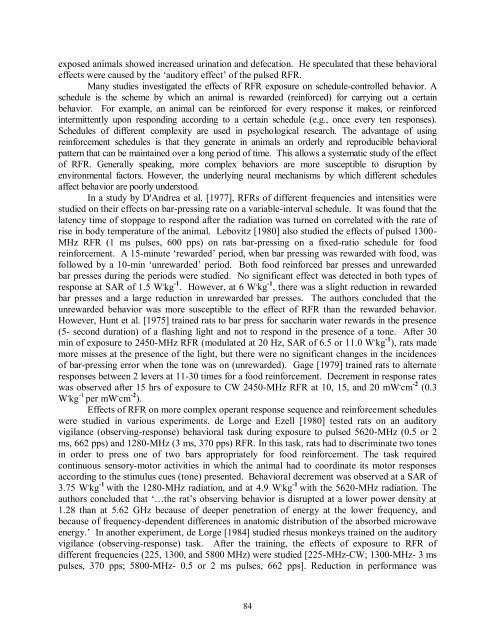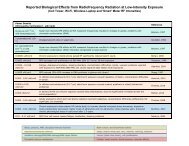Evidence for Effects on Neurology and Behavior - BioInitiative Report
Evidence for Effects on Neurology and Behavior - BioInitiative Report
Evidence for Effects on Neurology and Behavior - BioInitiative Report
You also want an ePaper? Increase the reach of your titles
YUMPU automatically turns print PDFs into web optimized ePapers that Google loves.
exposed animals showed increased urinati<strong>on</strong> <strong>and</strong> defecati<strong>on</strong>. He speculated that these behavioral<br />
effects were caused by the ‘auditory effect’ of the pulsed RFR.<br />
Many studies investigated the effects of RFR exposure <strong>on</strong> schedule-c<strong>on</strong>trolled behavior. A<br />
schedule is the scheme by which an animal is rewarded (rein<str<strong>on</strong>g>for</str<strong>on</strong>g>ced) <str<strong>on</strong>g>for</str<strong>on</strong>g> carrying out a certain<br />
behavior. For example, an animal can be rein<str<strong>on</strong>g>for</str<strong>on</strong>g>ced <str<strong>on</strong>g>for</str<strong>on</strong>g> every resp<strong>on</strong>se it makes, or rein<str<strong>on</strong>g>for</str<strong>on</strong>g>ced<br />
intermittently up<strong>on</strong> resp<strong>on</strong>ding according to a certain schedule (e.g., <strong>on</strong>ce every ten resp<strong>on</strong>ses).<br />
Schedules of different complexity are used in psychological research. The advantage of using<br />
rein<str<strong>on</strong>g>for</str<strong>on</strong>g>cement schedules is that they generate in animals an orderly <strong>and</strong> reproducible behavioral<br />
pattern that can be maintained over a l<strong>on</strong>g period of time. This allows a systematic study of the effect<br />
of RFR. Generally speaking, more complex behaviors are more susceptible to disrupti<strong>on</strong> by<br />
envir<strong>on</strong>mental factors. However, the underlying neural mechanisms by which different schedules<br />
affect behavior are poorly understood.<br />
In a study by D'Andrea et al. [1977], RFRs of different frequencies <strong>and</strong> intensities were<br />
studied <strong>on</strong> their effects <strong>on</strong> bar-pressing rate <strong>on</strong> a variable-interval schedule. It was found that the<br />
latency time of stoppage to resp<strong>on</strong>d after the radiati<strong>on</strong> was turned <strong>on</strong> correlated with the rate of<br />
rise in body temperature of the animal. Lebovitz [1980] also studied the effects of pulsed 1300-<br />
MHz RFR (1 ms pulses, 600 pps) <strong>on</strong> rats bar-pressing <strong>on</strong> a fixed-ratio schedule <str<strong>on</strong>g>for</str<strong>on</strong>g> food<br />
rein<str<strong>on</strong>g>for</str<strong>on</strong>g>cement. A 15-minute ‘rewarded’ period, when bar pressing was rewarded with food, was<br />
followed by a 10-min ‘unrewarded’ period. Both food rein<str<strong>on</strong>g>for</str<strong>on</strong>g>ced bar presses <strong>and</strong> unrewarded<br />
bar presses during the periods were studied. No significant effect was detected in both types of<br />
resp<strong>on</strong>se at SAR of 1.5 W . kg -1 . However, at 6 W . kg -1 , there was a slight reducti<strong>on</strong> in rewarded<br />
bar presses <strong>and</strong> a large reducti<strong>on</strong> in unrewarded bar presses. The authors c<strong>on</strong>cluded that the<br />
unrewarded behavior was more susceptible to the effect of RFR than the rewarded behavior.<br />
However, Hunt et al. [1975] trained rats to bar press <str<strong>on</strong>g>for</str<strong>on</strong>g> saccharin water rewards in the presence<br />
(5- sec<strong>on</strong>d durati<strong>on</strong>) of a flashing light <strong>and</strong> not to resp<strong>on</strong>d in the presence of a t<strong>on</strong>e. After 30<br />
min of exposure to 2450-MHz RFR (modulated at 20 Hz, SAR of 6.5 or 11.0 W . kg -1 ), rats made<br />
more misses at the presence of the light, but there were no significant changes in the incidences<br />
of bar-pressing error when the t<strong>on</strong>e was <strong>on</strong> (unrewarded). Gage [1979] trained rats to alternate<br />
resp<strong>on</strong>ses between 2 levers at 11-30 times <str<strong>on</strong>g>for</str<strong>on</strong>g> a food rein<str<strong>on</strong>g>for</str<strong>on</strong>g>cement. Decrement in resp<strong>on</strong>se rates<br />
was observed after 15 hrs of exposure to CW 2450-MHz RFR at 10, 15, <strong>and</strong> 20 mW . cm -2 (0.3<br />
W . kg -1 per mW . cm -2 ).<br />
<str<strong>on</strong>g>Effects</str<strong>on</strong>g> of RFR <strong>on</strong> more complex operant resp<strong>on</strong>se sequence <strong>and</strong> rein<str<strong>on</strong>g>for</str<strong>on</strong>g>cement schedules<br />
were studied in various experiments. de Lorge <strong>and</strong> Ezell [1980] tested rats <strong>on</strong> an auditory<br />
vigilance (observing-resp<strong>on</strong>se) behavioral task during exposure to pulsed 5620-MHz (0.5 or 2<br />
ms, 662 pps) <strong>and</strong> 1280-MHz (3 ms, 370 pps) RFR. In this task, rats had to discriminate two t<strong>on</strong>es<br />
in order to press <strong>on</strong>e of two bars appropriately <str<strong>on</strong>g>for</str<strong>on</strong>g> food rein<str<strong>on</strong>g>for</str<strong>on</strong>g>cement. The task required<br />
c<strong>on</strong>tinuous sensory-motor activities in which the animal had to coordinate its motor resp<strong>on</strong>ses<br />
according to the stimulus cues (t<strong>on</strong>e) presented. <strong>Behavior</strong>al decrement was observed at a SAR of<br />
3.75 W . kg -1 with the 1280-MHz radiati<strong>on</strong>, <strong>and</strong> at 4.9 W . kg -1 with the 5620-MHz radiati<strong>on</strong>. The<br />
authors c<strong>on</strong>cluded that ‘…the rat’s observing behavior is disrupted at a lower power density at<br />
1.28 than at 5.62 GHz because of deeper penetrati<strong>on</strong> of energy at the lower frequency, <strong>and</strong><br />
because of frequency-dependent differences in anatomic distributi<strong>on</strong> of the absorbed microwave<br />
energy.’ In another experiment, de Lorge [1984] studied rhesus m<strong>on</strong>keys trained <strong>on</strong> the auditory<br />
vigilance (observing-resp<strong>on</strong>se) task. After the training, the effects of exposure to RFR of<br />
different frequencies (225, 1300, <strong>and</strong> 5800 MHz) were studied [225-MHz-CW; 1300-MHz- 3 ms<br />
pulses, 370 pps; 5800-MHz- 0.5 or 2 ms pulses, 662 pps]. Reducti<strong>on</strong> in per<str<strong>on</strong>g>for</str<strong>on</strong>g>mance was<br />
84



